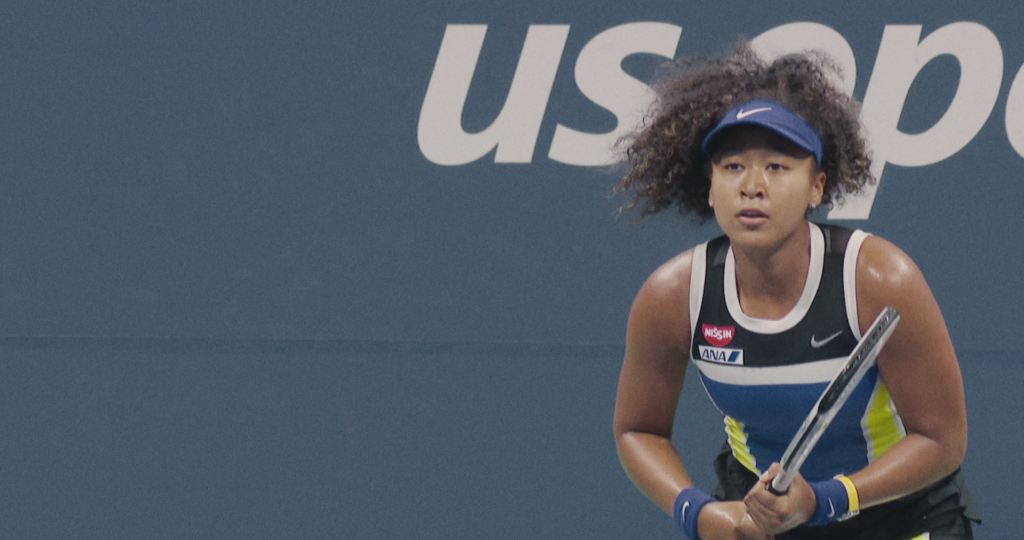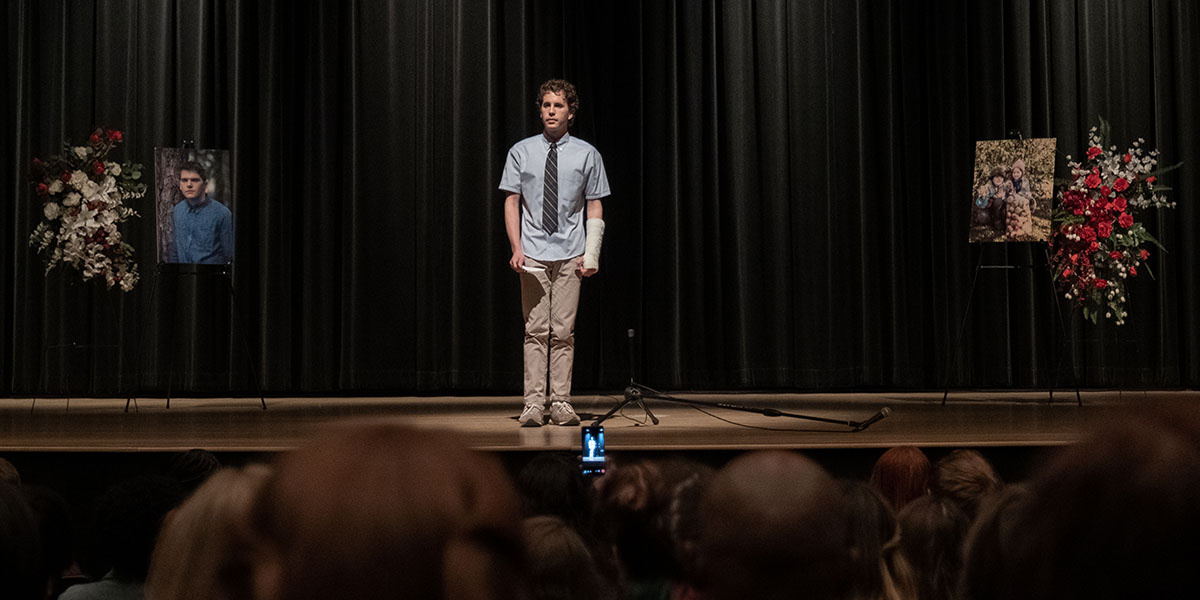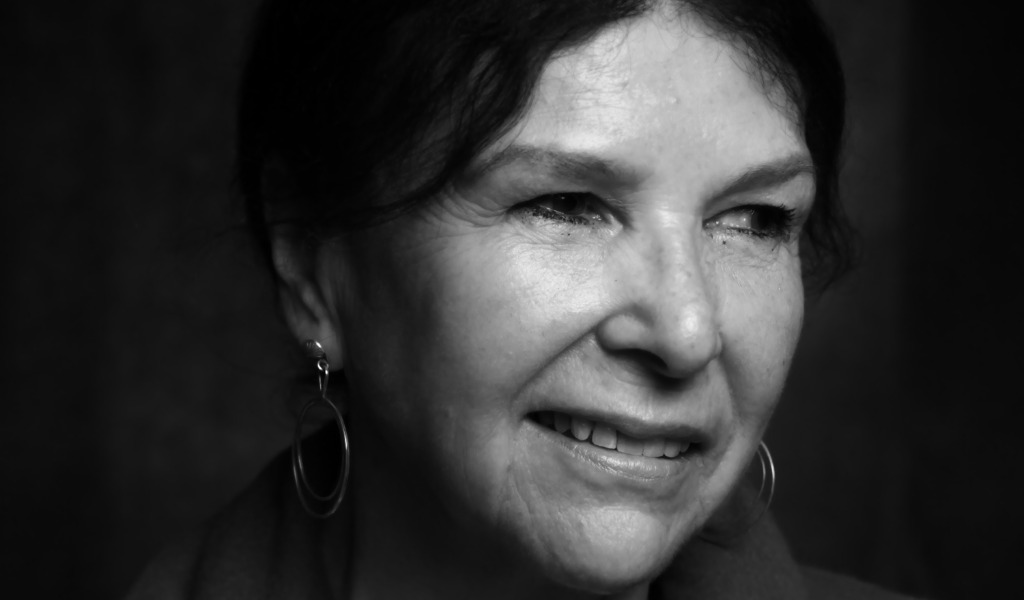Naomi Osaka serves a mean forehand. The public attention to the tennis player’s success, however, has been sharply backhanded. The Netflix mini-series Naomi Osaka, directed by Garrett Bradley (Time) offers a window into the world of a young athlete whose raw power on the court took the world by storm. Shot over two years in an intimate verité style with commendable access to the usually media-shy Osaka, Bradley’s doc captures the drive it takes to win. Naomi Osaka, however, is also an essay about the costs of fame. Osaka’s story and success offer perspective on the personal and existential toll one may encounter with a life on the court, the responsibility that celebrity brings, and the inevitable backlash that comes with the spotlight.
The doc series could easily be a feature film and, perhaps, be more successful as one if all three parts were unified. The opening act sets up Osaka’s rise energetically if predictably, but the series lags in its meandering second chapter, whose meditative style could work for fans of Bradley’s Time but not necessarily for devotees of the streamer’s other over-caffeinated doc series. Bradley nevertheless brings the three-parter to an exceptionally strong finale that connects a lot of weighty material and confronts questions of race, identity, and celebrity in a fragmented world.
Part 1, “Rise,” recaps Osaka’s ascension to fame. The episode emphasizes her heritage as a mixed race athlete with a Japanese mother and Haitian father. Born in Osaka, Japan, and raised in Beverly Hills, California, Osaka’s rise to the spotlight has been underscored by questions of identity and belonging. On one hand, race helped made headlines when she defeated Serena Williams at the U.S. Open in 2018 and became the first Japanese solo athlete to win a Grand Slam. But in doing so, the press defined Osaka before she could define herself.
Naomi Osaka weaves between the games leading up to this climatic showdown with Williams and images of Osaka’s personal life outside the court. Fleeting and meditative observational footage shows a young athlete uncomfortable with stardom and the weighty questions she’s asked to shoulder. On one hand, Osaka perfectly embodies the double bind that people with mixed race identities face as media coverage emphasizes either her Japanese heritage or her Blackness. The latter becomes especially contentious when she plays for the Japanese team and draws criticism that declining the American team suggests a rejection of her Blackness. She counters that race and ethnicity are different things, but at this point in Bradley’s observation, Osaka clearly doesn’t know what to do with that dilemma.
Part 2, “Champion Mentality,” continues this line of questioning as Osaka navigates her passion for tennis and her discomfort with the spotlight. Again cutting between exciting footage of Osaka in her element on the courts and images of her private life, Bradley considers questions of youth, identity, and the media by observing Osaka’s growth. As her star power heightens, Osaka’s celebrity invites some novel moments that illustrate her significance to audiences as well as other tragedies of everyday life that resonate late in the series. (Although an over-reliance on canted angles during the tennis matches proves annoying.)
At New York Fashion Week, a Japanese model pulls Osaka onto the runway to celebrate her trailblazing strength. While on the court, Osaka’s personal box houses her family along with supporters like late basketball icon Kobe Bryant and football star Colin Kaepernick, who famously took a knee during the national anthem at a 2016 game to protest police brutality against Black lives. Although Bryant’s unexpected death in 2020 affords the doc an emotional scene with Osaka, Kaepernick’s significance and legacy leads to the series’ third and easily strongest act.
The third episode, “New Blueprint,” synthesizes the themes of the preceding chapters and offers an invigorating tale for the times. Osaka finds her groove in the spotlight amid the tumult of 2020. The resurgence of the Black Lives Matter movement following the murder of George Floyd inspires her to own both herself and the spotlight. She grows from being a shy celebrity to a proud Black-Japanese star who uses her platform to inspire change.
The doc sees Osaka march on the streets with protesters, an act that offers an eye-opening and emotional toll. She draws criticism when she follows the lead of other athletes who withdraw from their scheduled games to protest the shooting of Jacob Blake by police, but she is the only tennis star to do so. The controversy is more about the ensuing one-day delay of the Cincinnati Open than the ongoing violence against Black lives. Osaka doubles down when she decides to use her platform to amplify the message by wearing seven different masks at the U.S. Open, each one emblazoned with the name of a Black American whose life was taken by police. Again connecting her public life with her private world, Bradley sees Osaka explore her Black roots in addition to her Japanese heritage as she learns how connecting with both races ultimately grounds her.
Naomi Osaka inevitably can’t cover the recent controversy that erupted when Osaka declined mandatory media participation at the 2021 French Open, citing reasons of mental health, and eventually withdrew from Wimbledon. The furor of the recent events mirrors the controversy of Osaka’s BLM activism—and arguably draws fuel from it—so Bradley doesn’t necessarily need to include this recent event. Instead, the portrait of Osaka that precedes the present backlash speaks to the concerns of mental health that go undiscussed in professional sports. When strength is one’s currency, opening up can be perceived as a weakness. Osaka conveys this succinctly as she develops a relationship with Bradley and allows herself to be vulnerable before the camera.
Bradley really finds her groove with the third episode of Naomi Osaka and delivers a compelling character study that goes beyond celebrity to interrogate the power of individual acts during turbulent times. The first two episodes of Naomi Osaka admittedly feel more like a coup of access to a young star during the peak of her fame, but, as with Time, Bradley finds the real heart of her character study by sticking with her subject and observing her inner conflict. Stylistically, the series is the antithesis of Netflix’s prototypically slick docu-series as it adopts a slower and more methodical pace—nowhere near as quick as Osaka’s 200 km serve, but no less potent.
Naomi Osaka is now streaming on Netflix.














